As I’ve been told several times in the past weeks, Venice is a fish. I’ve visited briefly before, but never did I fully register its iconic shape. Now, in just six days, I can get from my apartment in Castello to San Marco (the tail of the fish to the tummy) and from San Basilio to Campo Santa Margherita (the chin of the fish to its cheek). Sometimes I can even find my way back without opening my giant touristy map that unfolds to the size of a newspaper. It’s unwieldy, but marks every Campo and Calle in this fish-shaped city made of 117* small islands that is in its entirety smaller than Central Park.
*Or 118. My textbooks vary on this.
Jacopo de'Barbari / Wikimedia Commons / Public Domain
This is the most famous map of Venice, a woodcarving by the 15th century artist Jacopo de’Barbari that demonstrates the fishy shape well. My Art in Venice course got to view the city from the campanile of the Basilica di San Giorgio Maggiore, a Palladian church with its own little island south of the fish. Supposedly this is where de’Barbari created the preliminary drawings for his fish. I don’t buy it, because I couldn’t see a fish at all from up there. I do know the Neo-Classical campanile is not the original and was in fact put up in the 18th century, so my best guess is that the tower used to be taller, or — and this I consider far more likely — de’Barbari worked from multiple surveyors’ drawings and texts and compiled them into this detailed and lovely image that now decorates postcards, bags, and tacky merch of all stripes.
I see no fish from here. Photo by me!
My class’ next stop was not on the fish at all, but on the tiny island of Torcello, population 10. People, that is. There were quite a few pigeons congregating on the facade of the old Veneto-Byzantine Basilica di Santa Maria Assunta. There were no photos allowed inside, but it’s all very well; the old cathedral could easily benefit from a conservation effort.
Closeup on the façade of the Basilica di Santa Maria Assunta. Photo by me.
Speaking of conservation, everyone in Venice seems to agree that cruise ships are a blight. They disrupt viewpoints, cruise tourism rarely gives the city a considerable financial boost, and the polluted and turbulent water has a corrosive effect on the city’s delicate silt and mud islands. Since the only other time I’ve been to Venice has been on a cruise ship, I think I’ll have to think on it a little bit longer.
Fino alla prossima volta!
A Renaissance guardian watches over Venice's modern fleet. Photo by me.



